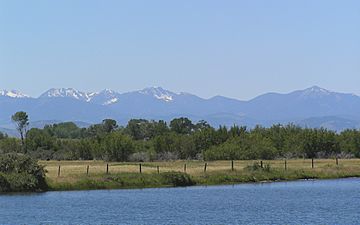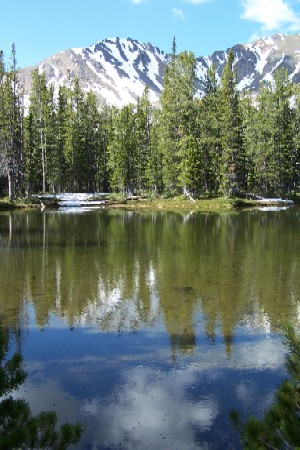Tobacco Root Mountains facts for kids
Quick facts for kids Tobacco Root Mountains |
|
|---|---|

Panoramic view of Tobacco Roots
|
|
| Highest point | |
| Peak | Hollowtop Peak |
| Elevation | 10,604 ft (3,232 m) |
| Geography | |
| Country | United States |
| State | Montana |
| Range coordinates | 45°33.3′N 111°58.5′W / 45.5550°N 111.9750°W |
| Parent range | Rocky Mountains |
The Tobacco Root Mountains are a mountain range located in the northern Rocky Mountains. They sit between the Jefferson and Madison Rivers in southwest Montana, United States. The highest point in the range is Hollowtop Peak, which stands at about 10,604 feet (3,232 meters) tall. In total, there are 43 peaks in this range that rise above 10,000 feet (3,048 meters).
A large part of the central Tobacco Root Mountains is within the Beaverhead-Deerlodge National Forest. This area was once very important for mining gold, especially from the 1880s to the 1930s. The high peaks of these mountains were shaped by glaciers during the ice age, and many of the stream valleys once held large valley glaciers.
Contents
How the Mountains Got Their Name
When Lewis and Clark explored southwest Montana in 1805, they named many rivers. However, they didn't record any names for the mountain ranges. Early maps, like the 1865 DeLacey Map of Montana Territory, also didn't name the Tobacco Roots.
The first time these mountains were mentioned in writing was in 1873. A report by Ferdinand Vandeveer Hayden called them the "South Bowlder Range." Later, the U.S. Geological Survey (USGS) called them the "Jefferson Range" on some maps.
The name "Tobacco Root Mountains" first appeared in print in 1914 in a report about mining areas. It was also used in a paper about the Boulder Batholith in 1918. Since then, "Tobacco Root" has been the most common name used on maps and in official reports.
Why "Tobacco Root"?
It's not completely clear how the Tobacco Root Mountains got their name. One idea comes from John Willard, who said that Native Americans and early trappers found a special root in these mountains. When this root was dried and mixed with other plants, it could be used as a substitute for tobacco. This root was thought to be a type of mullein plant.
Another idea is that "tobacco root" was an old name for a type of arnica plant. Arnica is a wildflower that grows in Western Montana, including in the Tobacco Root Mountains.
Some sources also suggest the root might have been a variety of the bitterroot plant, which is Montana's state flower. Shoshone Native Americans reportedly cooked and ate this root, and it was said to smell like tobacco.
Mountain Geology
The center of the Tobacco Root Mountains has a large body of rock called the Tobacco Root Batholith. A batholith is a very large mass of igneous rock that formed deep underground from cooled magma. This batholith is made of granite and pushed its way into older rocks, like Archean gneisses and schists.
Important gold deposits in the area seem to be connected to this batholith and to cracks in the earth called faults. The northern part of the Tobacco Roots also has layers of sedimentary and volcanic rocks that were pushed and folded a long time ago. These layers include older rocks from the Proterozoic era and younger rocks from the Cretaceous period.
Land and Wildlife
The land in the Tobacco Root Mountains is mostly used for livestock grazing and logging. Most of the land is privately owned, but a good portion is managed by U.S. Federal Agencies, like the Bureau of Land Management (BLM) and the U.S. Forest Service (USFS).
Many different animals live in the North Tobacco Root Mountains and Foothills. There are 244 types of land animals with backbones found here. These include common animals like whitetail and mule deer, elk, and black bears.
The area is also home to some "Tier I" species, which are native animals that need the most help with conservation in Montana. These include the western toad, flammulated owl, bald eagle, Townsend's big-eared bat, grizzly bear, and Canada lynx. These animals are at risk because their homes are being lost or damaged, often due to human population growth and development.
Images for kids
-
Tobacco Root Mountains SW Face from Twin Bridges, Montana



